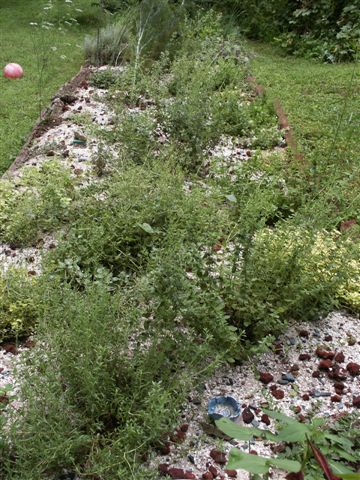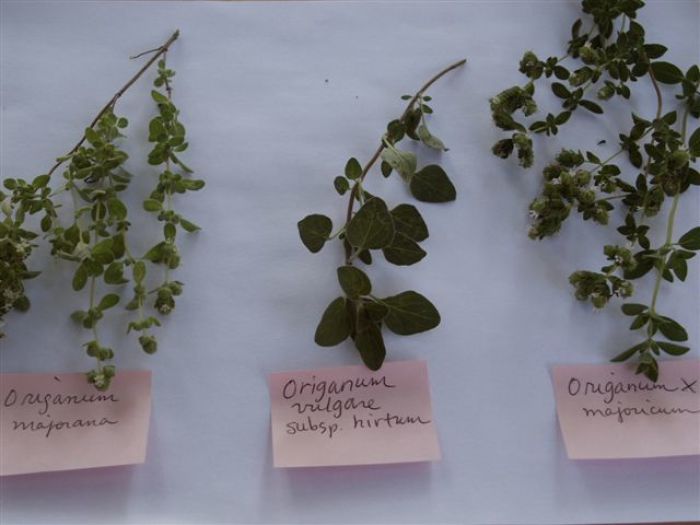Learn the Basics of Growing Outstanding Oregano and Marjoram
These fresh herbs are not always available at the grocery store, so it is worth it to cultivate them yourself

Oregano was named by the Greeks from oros, “mountain,” and ganos, “joy.” Its history, 1,300 years longer than marjoram’s, is mainly medicinal, with the relief of ailments from toothaches to opium addiction claimed by a long list of herbalists. Native Americans have known oregano for generations and have used it as a medicinal tea and as a flavoring for meats. The Spanish and Italians began recording its use for cooking during the fourteenth century, especially in meat and vegetable stews, and with shellfish. Since World War II, when spice merchants began promoting and importing it in quantities, oregano has moved from obscurity to being one of the most popular dried herbs in the United States.
Delightful myths and lovely uses surround sweet marjoram, while herbal remedies and hearty dishes are associated with oregano, its close cousin. Marjoram has long been one of the most popular culinary herbs. Its cultivation in the Mediterranean has been recorded for twelve centuries, spreading from its native Portugal to Central Europe. Recipes dating from the Renaissance call for marjoram in salads, in egg dishes, with rice, and with every variety of meat and fish. It was used to flavor beer before hops, and as a tea in England before Eastern teas were imported. Marjoram’s fragrance is still prized by perfume and soap makers as well as by cooks. I share with the bees the enjoyment of marjoram’s blossoms at the end of the summer. While drying the clusters of small purple flowers, I anticipate the further pleasure of our herb and flower potpourri.
Choose a variety based on flavor and zonal hardiness
The sweetness of marjoram’s aroma and the spiciness of oregano’s complement one another equally well in the kitchen. Their use together and the similarity of their appearance and growing habits have caused problems with identification for cooks and herbalists alike. It is worthwhile to sort through the subspecies and cultivars, as flavor, aroma, and cold hardiness vary greatly.
Sweet marjoram, which is a tender perennial in my Zone 7 garden is classified as Origanum majorana. Origanum × majoricum is a hybrid cross of sweet marjoram and Origanum vulgare (some say subspecies virens), and is sold as Italian oregano, Sicilian oregano, or hardy marjoram. Another variety worth mentioning is Greek oregano, also called pot marjoram; like marjoram, it is not winter hardy. This is O. onites, with a distinctive sharp aroma and spicy flavor that is preferred for most Greek dishes. The aforementioned are the most popular origanums for culinary use. True-to-type culinary marjoram and oregano are mostly cutting-grown; marjoram has flowers ranging from white to pale pink, and the oreganos have white to purple blooms.

The characteristics that identify fresh marjoram are a perfume reminiscent of sweet broom and mint, pale green leaves with faint silvery shadows and a slightly bitter, resinous flavor. When dried, marjoram retains its sweet aroma, and its color becomes a pale grayish green. Fresh oregano has a spicier fragrance than marjoram, with hints of clove and balsam. O. × majoricum, which is commonly cultivated in the United States, Spain, Portugal, and Italy, combines the sweetness of marjoram with the spiciness of oregano and is my personal favorite in the kitchen.
Though the nomenclature for O. × majoricum may be confounding, there is no need to be confused about this excellent herb if you let your nose, mouth, and eyes be your guides. If it smells sweet like sweet marjoram, then you are on the right track. When you are tasting a leaf, it should tingle on your tongue with the familiar spicy pungency of oregano, yet the sweetness should round out the spice, and it should be only very mildly hot. If it is pungent and biting hot on the tongue, with a rather dull spicy taste, you don’t have the right plant. Sometimes we might desire a hot, spicy-tasting oregano; however, that is not what we are looking for here.
Origanum vulgare may be called practically anything, including wild marjoram, winter marjoram, and wild oregano, and it is generally not the best flavor for culinary use. The plants known as O. vulgare, which are native to Europe, range from downright burning hot on the tongue to sort of bland and not very tasty. Greek oregano (O. onites) is another example of a hot, spicy herb. Leaves dry to a lighter color, and their flavor is very pungent—spicy with a hint of peppermint, pine, and sometimes clove. Both of these oreganos’ leaves are more oval, pointed, and larger than marjoram’s.
Tips for growing your own oregano and marjoram
Since fresh oregano and marjoram are not always available in American markets, it is worth the small effort to cultivate them yourself. O. × majoricum is a hardy perennial that will survive northern winters if well mulched. O. onites and O. majorana are perennials only in mild Mediterranean-like climates, but both do well in containers with enriched, well-drained soil indoors for the winter.
The Origanum family likes good drainage and prefers to be kept free of weeds, with enough room around each plant for its fine-branching lateral roots. These plants do best in full sun, with fertilization about once a month. They are fairly unfussy; if you cut them back early in the season just before they form flower buds, you will get an extra harvest. They can be pruned after flowering and again in the early fall. They do need to be divided every two or three years, as they spread and use up all of the nutrients in the soil.
Preserving and using oregano and marjoram
Both marjoram and oregano dry well and retain their flavor; in fact, I prefer them dried for some hardy winter soups, stews, casseroles, pilafs, polenta, and of course in tomato sauces. Crumbling some sweet-scented dried oregano or marjoram into olive oil when making garlic bread elevates this simple everyday dish to another level. The repertoire of a culinary artist would be notably lacking without the origanums.






Comments
Log in or create an account to post a comment.
Sign up Log in